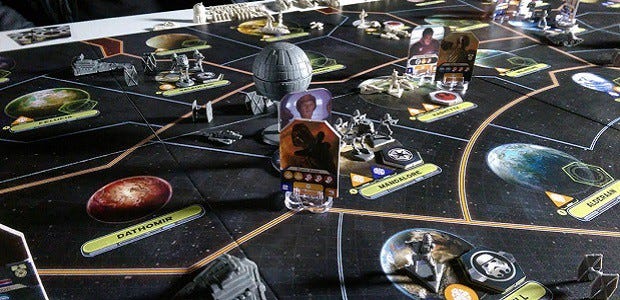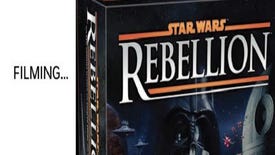Cardboard Children: Star Wars Rebellion Part One
Rebel rebel
Hello youse.
Star Wars: Rebellion is a two-player board game from Fantasy Flight Games, re-telling the story of the original Star Wars trilogy in about four hours. The game can also be played with more players, in teams, but the best way to play seems to be head-to-head. It's the Empire vs The Rebel Alliance, across the entire Star Wars galaxy, and it encompasses strategy, tactics, combat, deception and good old fashioned trash talking. It's an absolute slam dunk of an experience.
STAR WARS: REBELLION
We just shot a segment for the BBC TV show videoGaiden that features Star Wars: Rebellion as part of a broader conversation about modern board games. We shot the segment inside a planetarium – a grand setting for one of the most grand games I've ever played.
This is a remarkable production, a premium product – expensive, but with a great deal of value in the box. The game comes with a great number of miniatures representing the iconic Star Wars troops and ships - Stormtroopers, AT-ATs, X-Wings, Y-Wings, even the Star Destroyers and the Death Star itself. The board comes in two large segments, creating a massive galaxy to play across. And every planet is essential.
Every planet is essential to the experience, because here's the coolest hook of this Star Wars game – the Rebel player is hidden. The planet that holds the Rebel base is secret, and the Imperial player has to probe and expand across the galaxy looking for the base's secret location. While this is going on, the Rebel player is sabotaging Imperial plans and developments, and indulging in activities that increase Rebel sympathy.
The Imperial player wins by finding that Rebel base and levelling it. The Rebel player wins by surviving and increasing Rebel sympathies until the Empire is overthrown. It's a beautiful, exciting, dynamic setup.
By far the most impressive element of this board game is how streamlined it is. While there is incredible production quality and lots of great stuff inside the box, there isn't too much stuff. This is not one of those epic Fantasy Flight Games products of old, with a million chits and tokens to track and represent a million things. This design is super-clean, and any fuss or admin is kept to an absolute minimum, elevating the gameplay experience (and the storytelling experience) to the very top.
Oh, I'm excited. I'm excited. So here's how it works. It's not even difficult to explain.
At the start of the game, the Rebel player chooses a planet for her base. She then takes a “Probe Deck” full of cards representing all those planets on the board, and she removes the card that features her chosen base location. She keeps this. As the game progresses, and the Empire's probes do their work, and special Imperial missions are completed, the Imperial player will draw cards from this deck, eliminating planets from the search. It's beautiful. There is a mission card that the Empire player can activate that simply collects intel about the Rebel base, and this spits out more Probe Deck cards depending on how many units are at the Rebel base. So if the Rebel base is heavily populated, there's more chance of word leaking out about where it is. How cool is that? How logical and narratively strong is that? And that's just one card.
Cards, missions and leaders. These things are the key to the game. Each player starts the game with a small pool of leaders, the leaders affiliated with the two sides at the very start of A New Hope. These leaders are used to activate mission cards and advance troops from space sector to space sector. When a leader is “sent on a mission”, an opposing leader can be sent to oppose it, and there is a skill stat roll-off to see if the mission succeeds. It's very simple, very neat.
It becomes clear very quickly that choosing when and how to use leaders is crucial to success in the game. Send too many leaders on missions and you can't move troops out. Send the wrong leader on the wrong mission and you might lack the perfect leader to oppose one of your enemy's moves. It makes even that basic leader allocation phase exciting.
But the true excitement is in how you can use those decisions, and those mission cards, to lay traps. You can send a leader on a mission just to bring an opposing leader into action. Then you can enact another mission that affects that leader. What do I mean? Well, as an example, during my very first game I sucked a Rebel leader into a diplomacy situation then sent Boba Fett to capture her while she was there. So, in a story sense, leaders and missions interact with each other, creating the thrilling moments you expect from the Star Wars universe.
Combat is key to planetary conquest or liberation, and conquest and liberation is key to production. The Empire player can use missions and influence to turn a planet bad, but can also send down Stormtroopers to oppress even a Rebel-sympathising planet, making the people work for them. The Rebels have to win planets over to their side and clear Imperial forces from planets that are being subjugated. It's so fucking good. And you want your influence token on those planets, because these planets will be building new troops for each player, spitting troops onto a production queue. Yes, you can build new Star Destroyers and watch with wide eyes as they get closer to being finished with each passing round.
In a nutshell, that's the game. Send leaders on missions, send leaders into battle. Take over planets, or liberate them to make them your friend. Create new troops. Go again.
But there's much more to talk about, and next week we'll dig into the small details of this game, the stuff that makes Star Wars: Rebellion a true stand-out. We'll talk about sabotage, and recruitment, and story. We'll talk about individual cards that make you pump your fist in joy. And if the BBC allow, we'll show you a little bit of video of the game in action.
Be here next week for Part II.











